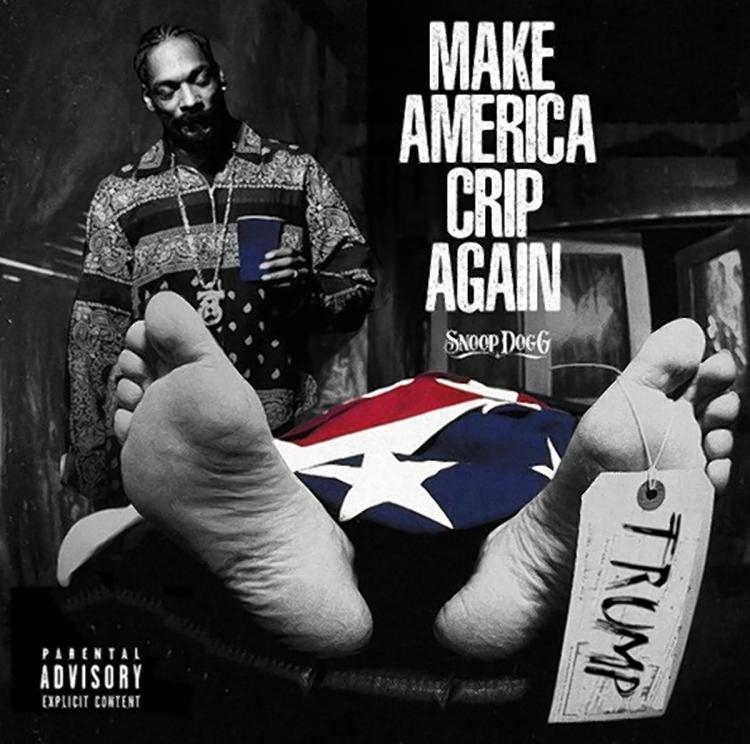
By Vince Gullo III | Staff Columnist
11/09/17
Recently, 18 time Grammy-nominated rapper and pop culture icon Snoop Dogg released the cover art for his new album: “Make America Crip Again.” The cover depicted Snoop, who, at his ripe age of 46, remains a force in the music and entertainment industry, standing over a dead body covered in an American flag, with a toe tag that read “Trump.”
Snoop Dogg has since changed the cover art after taking criticism for the art’s provocative message, but he definitely is not the first celebrity to make such blatant statements against the president. Comedian Kathy Griffin became the subject of national debate when she tweeted out a picture of her holding a fake severed head of Trump. Jokes at the expense of Trump have become the sweet spot of every late night monologue on television, and one cannot go on Twitter without seeing at least one Trump joke or criticism from a high-profile public figure. These jabs compile to create a new culture that revolves around tearing down the president in any way possible.
Snoop’s album cover went over the line for many. Depicting the President of the United States in a cartoonish or satirical way is one thing, but to portray him as dead enters a whole new realm of controversy. Similar to the Kathy Griffin photo, there were those who had no problem with the expression, but there was still enough controversy surrounding it that Snoop vouched for the cover’s removal from Instagram.
Regardless of how you line up politically, it’s obvious that Donald Trump has received a hefty load of criticism in his first months as president. In many ways, Trump is the perfect target. With his Cheeto-like complexion, toupee, lacking vocabulary and populist views, the guy is pretty much a walking meme. Add his inflammatory comments on pretty much every political and social topic and he becomes the subject of criticism from those of all political backgrounds. There’s no question that Trump deserves to be condemned on some level. For the most part, the criticisms are not only understandable, but well warranted. That being said, I think that critics of the president need to look at the effectiveness of their strategies and understand that an overload of criticism often evokes, at the very least, a disillusionment of their message. When it comes to such an important topic, an educated, well-calculated ‘less’ will always be more effective than a lazy, unlettered ‘more’.
Freedom of speech is at the crux of our American Identity. I stand by the right for people to say anything to anyone they want, and respect people’s right to be offended by it. I will even go as far as to say that criticizing the president is a necessary job for all Americans to partake in. But is going to such an extreme like depicting our nation’s leader as dead or executed a proper way to express the right to freedom of speech? Morality aside, is this portrayal even a strategically effective way to create, at the very least, a dialogue about change? I would understand if our country’s leader was Hitler (who Trump has drawn comparisons to by some critics), or Stalin or any other historically— awful leader, but at the end of the day he is just one cog in the massive multi-headed bureaucracy that is the United States government.
When Trump is depicted in ways such as laying dead on a table or with his head severed, that extreme portrayal draws comparisons to those of real dictators and thus trivializes the atrocities that those dictators committed. Yes, Trump’s comments may more-often-than-not be over the top, hurtful and asinine, but he is no Hitler. No racially-ignorant tweet or even a border wall could ever compare to events such as the Holocaust or other atrocities committed by infamous dictators. When you go to the extreme to describe something that is clearly not as serious as it’s being depicted, the effect is lost. Yes, many people dislike Trump, but the vast majority of these people know he is no evil dictator. When some of Trump’s most influential critics attempt to put him in the same light as that of a Hitler or Stalin, the criticism’s credibility takes a major hit, skewing the original message.
Despite its worthiness, a volume that often borders on obsession and a mentality that saying “something” is better than saying nothing at all has created a disenchantment to the important job of criticizing the president. This can most accurately be said for the criticism Trump receives daily on Twitter. Countless celebrities have led in the electronic bating of president Trump. The worst part is that these actions almost always elicit a response from Trump, who in his achillean inability to deflate a situation, adds fuel to the fire with a childish (in substance and delivery) response. Although these tweets make for good entertainment, between over-saturation, lack of solid content and a perpetual temptation to troll over having an educated dialogue, Twitter criticism of Trump has become white noise.
Although Trump is at an abysmal 37 percent approval rating, still 91 percent of his voters said they would vote for him again. This disparity shows that Trump’s top critics need to look for more effective strategies. Personally, I think more concentrated, well researched content at lower volumes would prove to be a more potent tactic than the ones currently in place. Every American has a right to criticize our elected officials. I believe that a more intellectual and composed approach will prove to be more effective in changing the views of lay observers and creating a national dialogue on our nation’s shortcomings.



